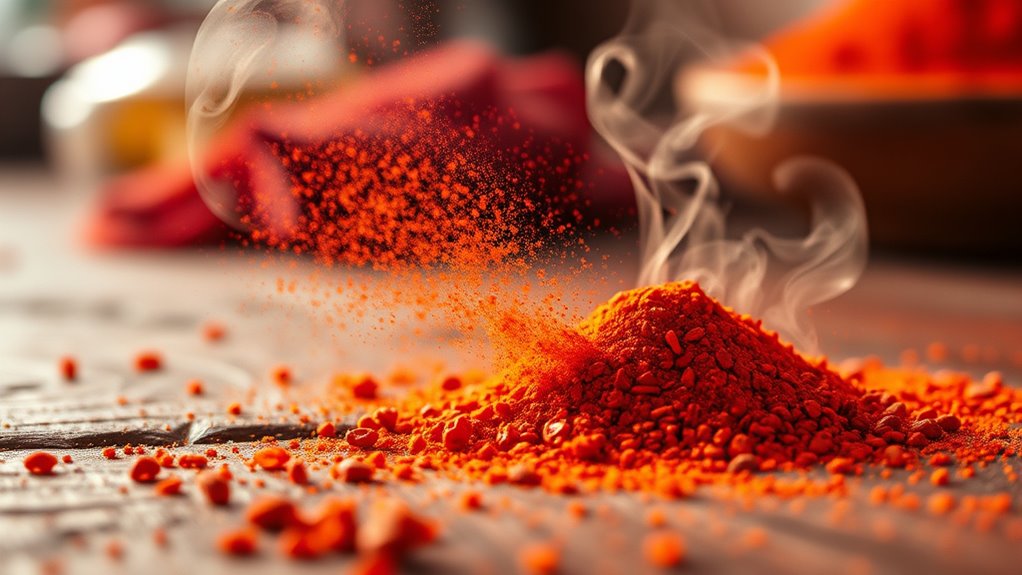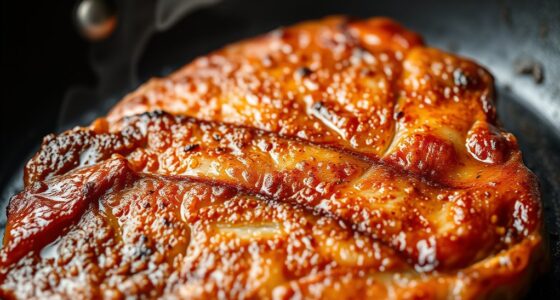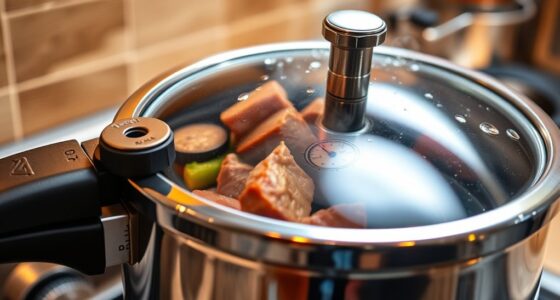Spice volatility means your spices’ aroma and flavor can change unpredictably due to supply issues, environmental factors, and chemical differences. When supply disruptions occur, the chemical makeup shifts, affecting aroma, heat, and consistency. Understanding how heat interacts with spice chemistry helps you release deeper flavors and adapt when supplies fluctuate. Stay aware of these factors, and you’ll be better equipped to maintain flavorful dishes, discovering more about controlling spice qualities along the way.
Key Takeaways
- Heat enhances the release of volatile oils, intensifying spice aroma during cooking.
- Variations in spice chemical composition due to supply issues affect how aroma develops with heat.
- Proper heating techniques can optimize aroma extraction despite chemical fluctuations.
- Understanding spice chemistry helps predict how heat influences flavor and aroma profiles.
- Supply disruptions can alter spice quality, requiring adjustments to effectively unlock aroma with heat.

Spice volatility has become a major concern for traders and consumers alike, as prices swing unpredictably due to supply disruptions, regulatory crackdowns, and shifting market demand. This unpredictability directly impacts your ability to incorporate spices into your culinary applications, whether you’re cooking at home or managing a restaurant. When spice prices fluctuate, you might find it challenging to maintain consistency in flavors or keep costs under control. Understanding the factors behind this volatility helps you anticipate changes and adapt your recipes accordingly.
At the heart of spice volatility lies their chemical composition, which influences both flavor and aroma. Many spices contain complex mixtures of volatile oils, alkaloids, and other compounds that give each spice its distinctive profile. For example, the fiery heat of chili peppers comes from capsaicin, while cinnamon’s sweet aroma is due to cinnamaldehyde. These chemical constituents are sensitive to environmental factors like climate, harvesting time, and storage conditions. When supply chains are disrupted—say, due to droughts or political instability—these factors can alter the chemical composition of spices, affecting their flavor intensity and aroma. Such changes can lead to inconsistent culinary results, forcing chefs and home cooks to adjust their seasoning techniques.
Spice chemical composition varies with environmental factors, impacting flavor and aroma, especially during supply disruptions.
Moreover, the chemical composition of spices influences how they behave when cooked. Some spices release their aroma quickly, while others develop deeper flavors over time. If the chemical makeup shifts because of supply issues, you might notice that a spice no longer provides the same aroma or heat, even if it looks and smells similar. This unpredictability can make it difficult to achieve the desired flavor profile consistently. For instance, a batch of cumin that has slightly altered chemical components may produce a different aroma, impacting the overall dish. As a result, you may need to experiment more or rely on alternative spices to maintain your culinary standards.
Additionally, regulatory crackdowns on certain spice imports can limit availability, forcing you to source alternatives or adjust recipes. When supply chains are strained, the chemical composition of available spices may differ from traditional varieties, further complicating your culinary applications. This scenario underscores the importance of understanding the chemical makeup of spices and how external factors influence them. By doing so, you can better predict flavor outcomes and develop flexibility in your cooking. Being aware of these dynamics allows you to adapt recipes, experiment with different spice blends, and still deliver flavorful dishes despite market fluctuations.
Furthermore, Kia Tuning can serve as a valuable analogy; just as tuning a vehicle involves understanding the complex interactions of components to optimize performance, understanding spice chemistry and supply factors allows cooks to optimize flavor consistency. By doing so, you can maintain the aroma and heat that define your culinary creations, even in unpredictable markets. Recognizing how supply disruptions alter spice chemistry empowers you to maintain the aroma and heat that define your culinary creations, even in unpredictable markets.
Frequently Asked Questions
How Do Different Cooking Methods Affect Spice Volatility?
When you cook with spices, different methods influence their volatility and aroma release. Sautéing or frying exposes spices to heat, inducing aroma through heat-induced aroma release, making flavors more intense. Boiling or simmering can cause moisture impact, which might dilute the spice’s potency and reduce volatility. Grilling and roasting also intensify aroma but can alter spice oils differently. Your choice of method directly affects how vibrant and fragrant your spices become.
Can Spice Volatility Vary Between Fresh and Dried Spices?
You’ll find that spice volatility does vary between fresh and dried spices. Fresh spices tend to preserve more volatile compounds, offering a vibrant aroma, while drying techniques can diminish these compounds over time. Proper freshness preservation methods help maintain flavor intensity. Dried spices often have less aroma due to moisture loss, but choosing quality drying techniques can minimize flavor loss, ensuring you get the most aroma and spice volatility from both fresh and dried options.
What Are the Health Implications of Volatile Spice Compounds?
You’re in for a spicy surprise! The volatile compounds in spices can offer health benefits like antioxidants, but they also pose potential risks if consumed in excess. These compounds may cause allergic reactions or irritation for some people. It’s important to enjoy spices in moderation and stay aware of how your body reacts, so you can savor their flavors while minimizing any health hazards. Balance is key!
How Does Storage Influence Spice Aroma and Heat?
You should pay close attention to storage conditions because they directly impact spice freshness, aroma, and heat. Properly stored spices in airtight containers, away from light and humidity, retain their volatile compounds longer. When you store them correctly, their aroma stays vibrant, and the heat remains potent. Conversely, poor storage causes aroma loss and reduces spice potency, making your dishes less flavorful and aromatic over time.
Are There Specific Spices That Retain Their Volatility Longer?
You might think all spices lose their aroma quickly, but some retain their volatility longer. For example, whole spices like cinnamon sticks or cloves preserve essential oils better during spice aging and storage. These spices hold onto their aroma and heat, thanks to their structure. Proper storage, away from light and heat, helps maintain their essential oil extraction potential, ensuring you get vibrant flavors and aromas even after extended periods.
Conclusion
As you embrace the dance of heat and aroma, remember that spice volatility mirrors life’s fleeting moments—each burst of flavor a spark of passion, each subtle hint a whisper of memory. Just as fire reveals hidden depths, your palate uncovers unseen layers within every spice. Let this fiery symphony symbolize your journey: bold, unpredictable, and vibrant. In embracing the heat, you liberate not just aroma, but the essence of discovery itself.









